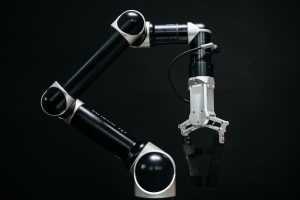With the increasing customer demand for products, businesses are looking to automate processes in an attempt to optimise their production processes and increase throughput. One form of automation that has been implemented in various industries is pick and place robots.
But what are pick and place robots and how do they work? In this guide, we delve into the ins and outs of pick and place robots to keep you up to date with the latest in automation.
- What is a Pick and Place Robot?
- How Do Pick and Place Robots Work?
- Different Types of Pick and Place Robots
- Benefits of Pick and Place Robots
- Industries That Utilise Pick and Place Robots
- Choose the Perfect Pick and Place Robot with Conveyor Systems
What is a Pick and Place Robot?

A pick and place robot is an automated robot that has the purpose of picking up items and placing them in another location. By automating this repetitive task, human resources can be placed elsewhere where their skills can be better utilised. This also increases the speed of production and throughput rates, meeting increased customer demand.
How Do Pick and Place Robots Work?
Pick and place robots are usually mounted on a stand that looks over items. Paired with vision systems and sensors, these pick and place robots can grab specific items as they pass the robot and place them in a desired location. This desired location can be another conveyor system or a stationary table.
Robotic Process Automation (RPA)
Robotics Process Automation (RPA) technology is used to guide pick and place robots and instruct them on what to do. This software is created by a software developer who codes a list of actions for the robot to carry out. The robot learns each action by copying a user performing the action and then mirroring them.
Components of a Pick and Place Robot
A pick and place robot is composed of various elements to perform its given actions perfectly. These components are:
- A Robotic Arm: This robotic arm tool is the extension of the robot. It is made from cylindrical or spherical parts and can extend and retract to reach items.
- End Effector: This element performs the actual action. Placed at the end of the robotic arm, the end effectors are interchangeable to carry out different actions. For example, there is an end effector made for gripping.
- Actuators: For the pick and place robot to move, the actuators allow for motion in the robotic arm and end effectors. There are various types of actuators, such as servo motors or stepper motors.
- Sensors: Also known as the eyes of the pick and place robot, sensors are used to identify the items that will be moved and help the robot accurately grab the item.
- Controllers: Essentially the brain of the operation, the controllers synchronise and control the movement of the actuators of the robot.
Different Types of Pick and Place Robots

Pick and place robots come in all shapes and sizes and have different purposes. Below are just a few examples of pick and place robots and their functions.
Cartesian Robots
This pick and place robot works on multi-planes to move items via X, Y and Z coordinates. This particular type of pick and place robot is great for scenarios where precise linear movements are needed.
Fast Pick Robots
Typically used in warehouses and fulfillment centres, these fast pick robots are used for high-speed picking operations. A fast pick robot is known for its high speed, precision and flexibility in handling items. Some fast pick robots can handle over 800 items an hour.
Robotic Arms
The most common form of pick and place robots, a robotic arm simply picks up an item and places it in a different location. With either a 5-axis or 6-axis configuration, these pick and place robots can handle a range of products with their interchangeable end effectors.
Delta Robots
When equipped with a vision system, a delta robot is able to detect objects with given specifications and carry out its operation with different effectors. This type of pick and place robot is ideal for sorting, packaging and assembly tasks.
Collaborative Robots (Cobot)
The collaborative element of this type of pick and place robot is its ability to work alongside humans. A Cobot can aid with picking and placing tasks as well as assembly, packaging and quality inspection. The sensors of these robots allow them to detect humans to avoid collisions.
Benefits of Pick and Place Robots
Pick and place robots are known for optimising the production process. From increasing the speed of production to boosting productivity, here are some of the benefits you can experience from implementing pick and place robots:
- Increased Productivity: Repetitive tasks can be automated at high speeds to increase productivity. As they are robots, pick and place robots can work continuously without breaks allowing for a higher throughput and efficiency.
- Improved Quality: The high accuracy and precision of these systems reduce the risk of errors or defects in products. This can lead to a reduction in waste and improved product quality.
- Enhanced Safety: When it comes to material handling in particular, pick and place robots can reduce the need for manual labour and therefore minimising the risk of injury.
- Flexibility: With the RPA in place, pick and place robots can be easily programmed to handle various products, sizes and configurations. This means new products or variants of current products will not dramatically disrupt the current production process.
- Space Efficiency: Pick and place robots are commonly placed on stands above conveyor belts or stations. This maximises the use of available floor space within the facility.
Industries That Utilise Pick and Place Robots
There are many industries that benefit from a pick and place robot due to its flexibility and versatility. Some common industries that take advantage of pick and place robots include:
Food and Beverage Industry
From transporting food products to handling raw ingredients, a pick and place robot has many applications in the food and beverage industry. For example, complete food items can be transferred from one stainless steel conveyor system to the packaging conveyor system with the use of a pick and place robot. Pick and place robots can also be used in the sorting and palletising of food products.
Electronics Manufacturing
Assembly is a key area pick and place robots are known to excel within. By increasing the speed and accuracy of picking up electrical components from one conveyor system and placing them on another conveyor system carrying circuit boards, a pick and place robot can increase productivity and production speed.
Automotive Industry
With the various assembly lines involved in the production process of the automotive industry, pick and place robots are essential in the handling of automotive components. From grabbing car parts from one conveyor to placing the item on the assembly line conveyor belt to be installed, a pick and place robot reduces the need to handle heavy items manually.
Logistics and Warehousing
Pick and place robots increase the productivity of a warehouse by optimising order fulfilment, sorting and palletising products and unloading and loading goods from shelves or conveyor systems. This speeds up processing time, allowing businesses to meet the increasing customer demand.
Pharmaceuticals
In an industry where precision and accuracy are crucial, pick and place robots can help with the precise handling of medications, vials, syringes and other pharmaceutical products during the packaging and labelling process.
Choose the Perfect Pick and Place Robot with Conveyor Systems
No matter what industry your business is in, a pick and place robot can help with the optimisation of your production or processing practices. By reducing the need for manual labour in these repetitive jobs, resources can be diverted to more complex tasks, which will lead to increased productivity. Additionally, automation allows for quicker production speeds and a higher quality of products, which in turn leads to greater customer satisfaction.
With all the benefits pick and place robots can bring, why not choose the perfect pick and place robot for your business with Conveyor Systems? If you need advice on what type of pick and place robot to choose, get in touch with us and our team will be happy to help. Experience increased productivity with the help of pick and place robots today!
Pick and Place Robot FAQs
Which type of robot is commonly used for pick and place operation?
The most common type of pick and place robot is a robotic arm. These simple pick and place robots work on a 5-axis or 6-axis configuration to perform standard pick and place operations.
How does a pick and place machine work?
A pick and place robot consists of a few different elements. This includes a robotic arm tool that works as the extension of the pick and place robot, the end effector that performs the task, actuators that facilitate movement, sensors that help the robot identify different products and the controllers that control the movement of the actuators.
How fast is the pick and place robot?
Pick and place robots are known to increase the speed of production but how is this measured? Most pick and place robots are about to move 300 to 800 items an hour. This is substantially more than a human would be able to handle. This shows how pick and place robots can increase the speed of production and reduce the need for human labour in repetitive tasks.
Related Articles
How to automate your operations for maximum impact














